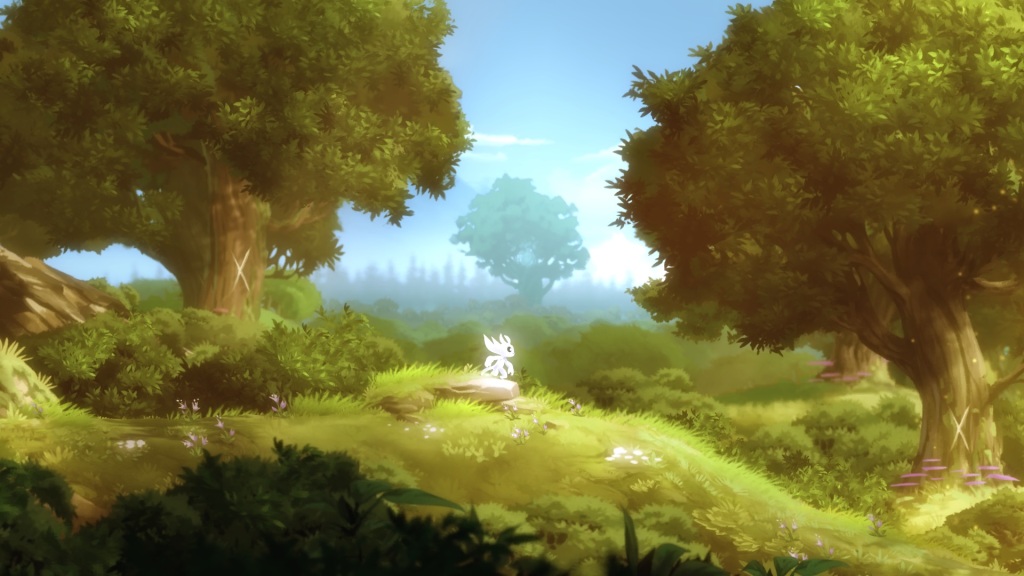Released in 2015 for Xbox One and PC, Moon Studios’ Ori and the Blind Forest became another favourite amongst gamers thanks to a combination of beautiful sights and sounds coupled with a tough as nails platformer of the “Metroidvania” variety. In March on 2016 an updated version of the game was released that tweaked the difficulty and added a fast travel system too.
Though not a big fan of the genre, I’ve found recently that games such as Rayman Legends, Guacamelee STCE and Mark of the Ninja have provided me with plenty of entertainment in a form that challenges some of my (very) old arcade reflexes.
The game tells the story of Ori, a white guardian spirit who is lost and later adopted by the creature Naru who raises him as her own child. The forest which they call home begins to die and soon Ori begins a journey to restore it back to health. That’s keeping it VERY brief but I really think the storytelling is great in the beginning as it is told is a series of player controlled vignettes and voice overs. It’s a touching tale that hits the right chords emotionally.
The game starts you off with your basic set a movements and a jump and as you progress through the game you’ll begin to unlock additional abilities that allow you to not only progress further but to access areas that you were previously unable to reach. These are unlocked via two ways – the first is via spirit trees that unlock core abilities which you will usually encounter along the way and the other is via a skill tree that allows the player to boost the core abilities based on three branches in Defence, Exploration and Offense.
If the player is willing to grind and accumulate experience they can unlock most of the skill branches but they will always be held back by the amount of abilities they have too so there is always a need to push on if you’re the kind of player interested in maxing out your character.
The platforming that is in store for players will give their thumbs a damned good workout – whether it be timing to avoid obstacles or to make your way up a sheer wall, there are moments that will require you to perform some pretty nifty manoeuvres to get yourself out of a jam.
It’s usually then that you also realise that you forgot to save. The game has a nice little system that lets the player save their spot in the exact location they are standing. Great for inching your way around a map but if you forget to do so after working through a large area you might find yourself frustrated to be back at the beginning again.
One thing you can’t deny about the game is that it is drop dead gorgeous – the art style has a painted quality that makes almost every screen worthy of a desktop background or ten. It definitely didn’t take me long to accrue a pile of screens for use here in my review.
The character design for Ori is unique in that it is almost entirely white which might normally be considered a bad choice and likely to blend into the scenery but it totally works here and is a cinch to spot amongst the colourful (and often dark) world. Enemies however seem almost generic by comparison. Mechanically they mainly exist to chip away at your health while making navigating through the world more difficult so in that respect they succeed quite well.
The audio adds another layer to the story backed by a soundtrack that at times is even able to cast a significant shadow over those amazing graphics. The intro benefits so much from the audio mystical stylings that if your aren’t turning it up you’re missing out.
The soundtrack’s composer, Gareth Coker, was interviewed last year at The Wayfaring Dreamer in relation to Ori’s music and it’s a great insight into his process in creating the sound.
Though the technical aspects of modern consoles tend to give incentive for developers to write games that push polygons over bitmaps, those who do have a preference for 2D games have and awful lot of horsepower at their disposal to make some very good looking games. They may be far fewer in number than in the 8 and 16 bit eras, but the abundance of visual style and production values put into them now really have provided gamers with some incredible examples of platformers that compare well to those that came before them.
If you’re into old school platformers but want something that looks and sounds good too it’s hard to go past this. I hope we get to see more from Moon Studios (a team composed of developers located all around the world) in the coming years because this is a damned good first game.
Ori and the Blind Forest Definitive Edition is out now for Xbox One and PC. Reviewed on Xbox One.
Categories: Gaming, Reviews & Impressions






One day I’ll definitely have to pick this up and give it a go.
LikeLiked by 1 person